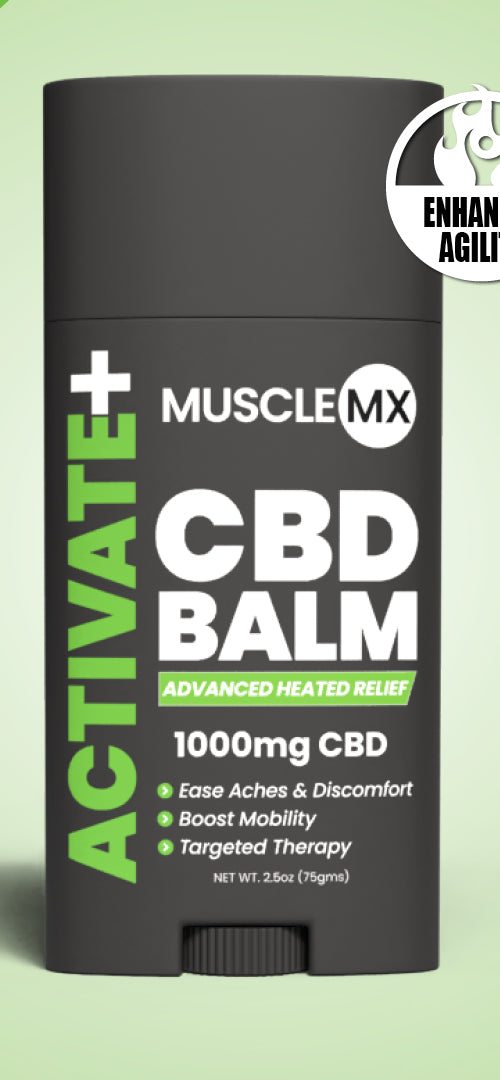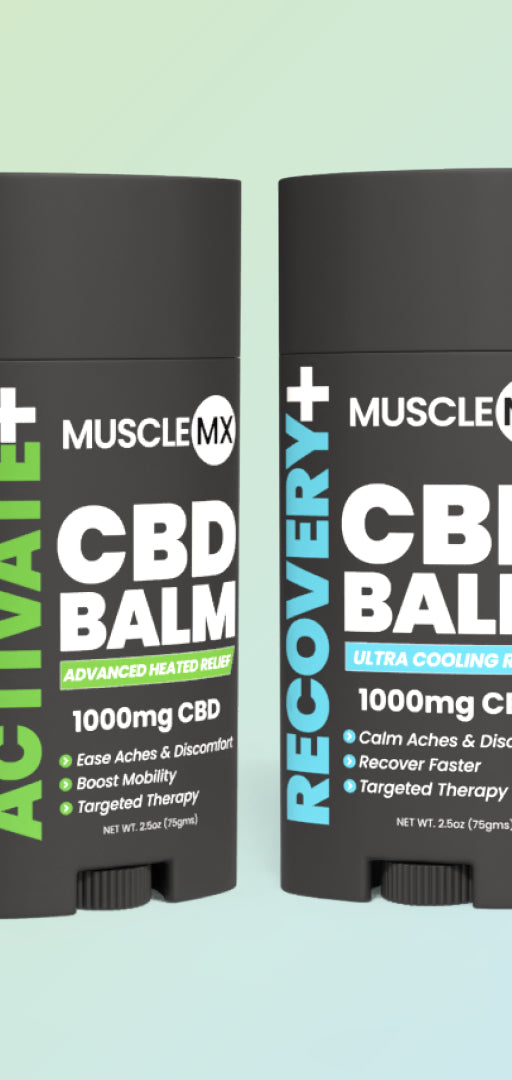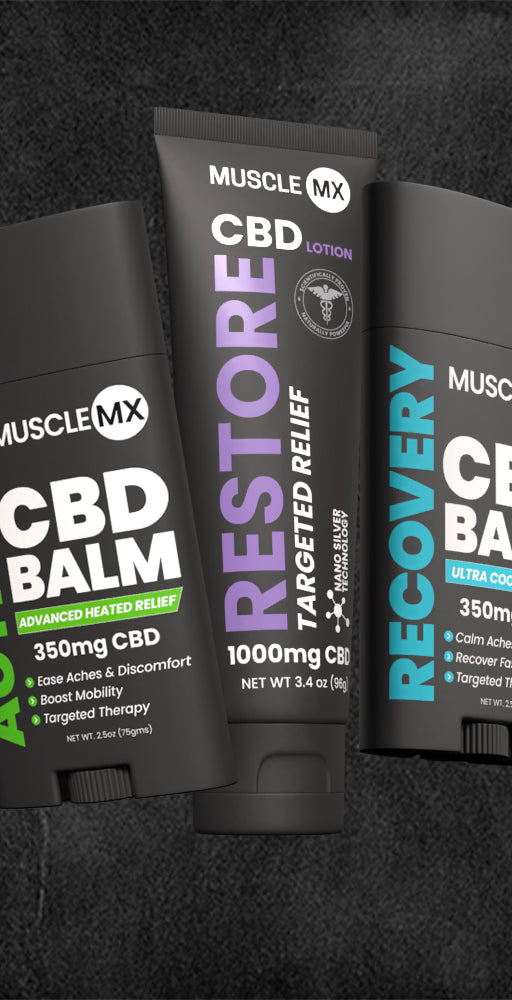Our knees are such crucial parts of our bodies because they support most of our body weight, enable our mobility, and can overcompensate for other problem areas in our bodies. If you have persistent, debilitating, sharp pain in one or both of your knees, it can feel like your life is on hold. What causes pain in the knee, and what steps can you take to get back to doing the things you love? Today, Muscle MX is diving into sharp knee pain.
Why Am I Feeling a Sharp Pain in My Knee?
The position of the knee in our body makes it one of the most important and simultaneously one of the most easy areas to injure. The knee is a joint, meaning that it’s where two straight bones come together, so it has a range of motion. Sometimes pain in the knee just affects how wide that range of motion is, but other times it can completely immobilize you — making walking, running, and even just climbing stairs difficult. There are a number of causes of knee pain, but first it’s helpful to identify what types of pain are usually associated with pain in the knee.
What Types of Pain Can Be Felt in the Knee?
There are several different categories of pain based on what’s causing it, why a part of the body is feeling pain, how the pain feels, and how long it lasts. Here are some of the main categories:
Somatic Pain
If the pain that you’re experiencing is because the pain sensors in your nerves in your body tissue are being stimulated, then this is referred to as nociceptive pain, and somatic pain is nociceptive. Somatic pain refers to pain that hurts because a specific area of body tissue is damaged or stimulated. When you get a headache, get a cut or scratch, sprain or strain a muscle, or break a bone, you’re experiencing somatic pain. This type of pain is felt in one particular area of the body, so knee pain would be considered somatic. Sharp, biting, sudden, and cramping are all words that might be used to describe somatic pain.
How Do Acute and Chronic Pain Differ?
Another way to classify pain is by how long it lasts. The two primary categories for types of pain by how long they affect us are acute and chronic pain. If pain is acute, it will typically immediately start getting better. It is best classified as short-term pain, and things like sports injuries, cuts, bruises, sprains, and similar trauma to the body are considered acute pain. If you experience acute pain, you’ll probably use words like sharp, intense, stabbing, biting, excruciating, or burning. Acute pain is often intense at first but gets better over time and usually doesn’t last permanently. If pain is chronic, it lasts for long periods of time — sometimes months, years, and, in some cases, even decades. Chronic pain could be caused by an injury that doesn’t heal properly, but it often it’s due to autoimmune diseases, neurological disorders, or post-surgery scar tissue. Chronic pain is often described as dull, aching, gnawing, or pulsating, and sometimes it will come and go with time, almost “turning on and off.” Knee pain could be either acute or chronic, depending on what's causing it and how long it lasts. For example, a broken kneecap would cause acute pain because it will start healing relatively quickly. However, if the break doesn’t heal properly, it could lead to pain that goes on for a long time and becomes chronic. If you would describe the pain you’re feeling in your knee as a sharp stabbing pain, then it could potentially fit into any number of the pain categories, but it’s probably somatic, meaning that it hurts in just one area. Pain is also likely to be acute if it comes on suddenly, but it could be chronic if you’ve been dealing with the same pain for an extended period of time. If there are sudden changes in feeling, if the area goes numb or starts tingling, or if your knee feels extremely hot or cold, your pain may be neuropathic.
What Causes Knee Pain?
There are many different reasons why you might experience sharp pain in your knee. Maybe you already know what the issue is — such as an injury, healing after surgery, or a recent diagnosis of an orthopedic disease (such as knee arthritis). However, if you suddenly feel pain in your knee and don’t know why (especially if your knee pain is accompanied by discomfort in the shinbone, hamstring, or thigh bone areas), it can be an even more stressful experience. Let’s look at some of the main causes of knee problems to help determine where the discomfort might be coming from.
Injuries to the Knee
If you fall and hit your knee while playing basketball or land on your knee after falling off your bike, you’ll experience sharp, biting pain immediately. Typically, knee injuries will heal quickly, and you’ll be back out doing what you love in no time. However, sometimes, they can lead to other, more long-term problems that require surgery or other interventions. Here are some common causes of knee injuries that cause sharp, stabbing pain:
-
ACL injury: The anterior cruciate ligament is located in the knee and is commonly torn or damaged due to sports injuries. A simple strain or sprain in the ligament usually isn’t serious, but a tear can require surgery and a lengthy recovery.
-
Meniscus injury: As part of the cartilage around the knee bones (the patella, tibia, and femur), the meniscus absorbs much of the shock placed on these bones by running, walking downstairs, and jumping. Like an ACL tear, a meniscus tear can be extremely painful and require surgery to repair.
-
Runner’s Knee: As indicated by its name, runner’s knee is often caused by the overuse, stress, and shock on the knee cartilage that comes with running. It’s usually not a serious condition, and can generally be remedied by taking a break from running for a while.
Arthritis in the Knee
Any condition that has an “-itis” attached to it indicates a problem with inflammation. Arthritis simply means that inflammation is taking place in one of the joints, and since the knee is one of the body’s most important joints, it’s a very common place to get arthritis. There are several types of arthritis that are caused by different factors, but they all generally feel dull, aching, and burning, though they can cause sharp pain as well. Some common forms of arthritis include:
-
Osteoarthritis: Usually coming on slowly, knee osteoarthritis happens when the cartilage that makes up the knee breaks down over time, causing a lot of pain, decreased mobility, and a harder time being physically active. Usually, it’s something that happens as we age or from overuse injuries and doesn’t come on all of a sudden.
-
Rheumatoid arthritis: The difference with rheumatoid arthritis is that it’s an autoimmune disorder where the body attacks the joints, including the knee. It can be extremely painful, especially when the lining around the knee joint wears away over time. Another difference from osteoarthritis is that rheumatoid arthritis can hit all at once with little warning, making it much more of a painful shock, and you can’t prepare for it the same way as other forms of arthritis.
-
Bursitis: This condition affects the bursa, which are fluid-filled sacs that are found in our joints. Knee bursitis causes intense pain as these sacs become inflamed and press on the cartilage and bone around the knee.
Post-Surgery Pain in the Knee
Following an operation or procedure for repairing a knee joint, there’s bound to be a good amount of pain. Often, post-surgery care will include a period of immobility, pain medications, and physical therapy. Sometimes after surgery, chronic pain will develop because of the soft tissue scarring that is created when the knee is cut into, whether in the front of the knee, the side of the knee, or even outside of the knee.
Knee Infections
Another possible culprit when it comes to knee pain is caused by infections in the knee. When there’s a bacterial infection in your knee, this is sometimes called septic arthritis. This can occur if you get an injury that causes a wound on the knee that then gets infected. Other times, a knee infection can occur after surgery, specifically if bacteria are introduced at the site where the surgery was performed. In these cases, the knee can become infected after the surgical site is closed.
Risk Factors
Because some viral, bacterial, and even fungal infections tend to target joints, the knee is often at a higher risk than other areas of the body. If you have an artificial knee joint that was put in during a knee replacement surgery, there is an even higher risk for infections. Other risk factors include having autoimmune disorders, taking immune system-suppressing medications, and having diabetes. As with any infection in the body, if you know the reason for the pain (for example, a cut on your knee that festers and then gets infected), then you might be able to treat it yourself. However, if you have a lot of swelling, a fever, or any abdominal issues that accompany your infection, you should seek medical attention immediately. It’s always better to be safe than sorry!
How Can You Address Knee Pain?
If you’re suffering from sharp knee pain, treatment will first depend on what’s causing it. If it’s a simple injury, some ice and anti-inflammatory medication might do the trick. If it’s more serious or caused by an autoimmune disorder, treatment might get a little more complicated. Of course, you should talk to your doctor or healthcare provider about your symptoms, but there are a number of things that you can do to ease tension and stress on the knee. Here are some common remedies:
-
Hot and cold: Alternating between hot and cold on the knee can be helpful for sharp knee pain. Using a cold compress or bag of ice can numb the pain while lessening inflammation, while something hot (like a jacuzzi) can help the knee can help soothe some of the pain away.
-
NSAIDS: Non-steroidal anti-inflammatories (NSAIDs) like ibuprofen are designed to lessen inflammation in the body by blocking some of the bodily chemicals that cause the inflammation. These can be purchased over the counter but may also be prescribed in higher doses for severe pain relief.
-
Stretching and movement: While it needs to be done absolutely carefully and safely, trying to maintain mobility in your joints, especially your knees, is extremely important to keeping active, fighting deterioration, and maintaining overall health. A simple list of safe exercises to practice each day can make a huge difference in your overall pain and discomfort. Additionally, getting a knee brace may help when you’re ready to start moving again.
-
Topicals: Balms, creams, rubs, and lotions can also make a big difference in your discomfort. Today there are many topicals that can be applied to your knee to reduce discomfort. Depending on your level of pain, some topicals may work better than others.
Getting to the Bottom of Sharp Pain in the Knee
Whatever the cause of your sharp knee pain, identifying what type of pain you’re experiencing can be the first step on the road toward starting to feel better. If you’re experiencing sharp pain that’s making it hard to get by on a day-to-day basis, it’s time to start dealing with it! Don’t wait or shrug it off for another day. Talk to medical professionals that you trust, and start exploring your options for treatment. Sources: Somatic symptom disorder - Symptoms and causes | Mayo Clinic Osteoarthritis vs. rheumatoid arthritis | Mayo Clinic Bursitis | Johns Hopkins Medicine
|










































